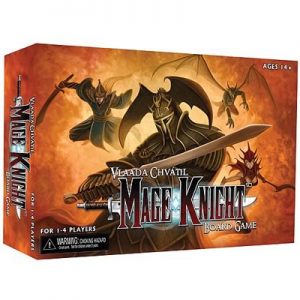Beschrijving
Min leeftijd: +14
Aantal spelers 2
Gem speelduur 90 min
Het Oostenrijkse leger is een coalitie-uitbreiding voor Commands & Colors Napoleonics.
Vóór de Napoleontische oorlogen strekte het Oostenrijkse rijk zich uit van Italië tot Nederland en van Polen tot de Balkan. Zijn ligging in het centrum van Europa maakte het echter tot het perfecte doelwit voor het revolutionaire Frankrijk en in april 1792 verklaarde Frankrijk de oorlog aan Oostenrijk. De eerste oorlog duurde 5 jaar. Oostenrijk hernieuwde de oorlog tegen Frankrijk in 1799 en opnieuw in 1805, maar werd in beide gevallen snel verslagen. In april 1809 viel Oostenrijk, toen het oordeelde dat het leger van Napoleon vastzat door de gevechten in Spanje, Beieren binnen, maar Napoleon herstelde zich snel en de nederlaag van Oostenrijk bij Wagram leidde tot een nieuw vernederend vredesverdrag. In 1812 werd Oostenrijk gedwongen troepen te leveren voor de rampzalige Russische campagne van Napoleon, maar in 1813 sloot Oostenrijk zich opnieuw aan bij de coalitie tegen hem.
Hoewel het Oostenrijkse leger het derde grootste ter wereld was, verloren de Oostenrijkers veel meer veldslagen dan ze wonnen. Ten tijde van de Napoleontische oorlogen was het Oostenrijkse leger een groot multinationaal leger, bestaande uit Oostenrijkers, Zweden, Hongaren, Engelsen, Schotten, Ieren, Walen, Polen, Russen, Oekraïners, Duitsers, Kroaten, Serviërs en zelfs Franse royalisten. De infanterieregimenten waren groot en enigszins betrouwbaar, maar de tactische formaties en oefeningen waren in het verleden nog steeds verankerd. De cavalerie, hoewel goed bereden, paste nog steeds de praktijk toe om hun formaties in kleine lichamen te verspreiden, wat hun gevechtseffectiviteit aanzienlijk verminderde. Over het algemeen boekte het Oostenrijkse leger veel successen op regimentsniveau, maar op brigade- en divisieniveau waren de commandanten tactisch niet bekwaam.
In deze uitbreiding vind je 18 historische scenario’s die zich richten op de veldslagen van het Oostenrijkse leger van 1805 tot 1814 tegen Napoleon, plus alle nieuwe eenheden die je nodig hebt voor deze gevechten.
Gevechten:
1805
Wertingen – 8 oktober 1805
Günzburg – 9 oktober 1805
Haslach – 11 oktober 1805
Elchingen – 14 oktober 1805
Verona – 18 oktober 1805
Caldiero – 30 oktober 1805
1809
Eckmühl – 21/22 april 1809
Regensburg – 23 april 1809
Ebelsberg – 3 mei 1809
Travis – 17/18 mei 1809
Aspern-Essling – 21/22 mei 1809
St. Michael-Leoben – 25 mei 1809
Wagram – 5/6 juli 1809
Stockerau – 8 juli 1809
1813
Dresden – 26/27 augustus 1813
Leipzig (Liebertwolkwitz) – 14 oktober 1813
Hanau – 30-31 oktober 1813
1814
Arcis-sur-Aube – 20/21 maart 1814
The Austrian Army is a Coalition expansion for Commands & Colors Napoleonics.
Prior to the Napoleon wars, the Austrian Empire stretched from Italy to the Netherlands and from Poland to the Balkans. Its position in the center of Europe, however, made it the perfect target for revolutionary France and in April 1792, France declared war on Austria. The first war lasted for 5 years. Austria renewed the war against France in 1799 and again in 1805, but in both cases was swiftly defeated. In April 1809, judging that Napoleon’s army was bogged down with the fighting in Spain, Austria invaded Bavaria, but Napoleon recovered quickly and Austria’s defeat at Wagram led to another humiliating peace treaty. In 1812 Austria was forced to provide troops for Napoleon’sthe disastrous Russian campaign, but in 1813 Austria again joined the coalition against him.
Even though the Austrian army was the third largest in the world, the Austrians lost many more battles than they won. At the time of the Napoleonic Wars, the Austrian army was a large multi-national army, made up of Austrians, Swedes, Hungarians, Englishmen, Scots, Irishmen, Walloons, Poles, Russians, Ukrainians, Germans, Croats, Serbs, and even French royalists. The infantry regiments were large and somewhat reliable, but the tactical formations and drill were still entrenched in the past. The cavalry, although well mounted, still applied the practice of scattering their formations in small bodies, which greatly reduced their combat effectiveness. In general, the Austrian army did enjoy many successes on a regimental level, but at the brigade and divisional levels its commanders were not tactically proficient.
In this expansion you will find 18 historical scenarios that focus on the Austrian Army battles from 1805 to 1814 against Napoleon, plus all the new units you’ll need to field for these engagements.
Battles:
1805
Wertingen – 8 October 1805
Günzburg – 9 October 1805
Haslach – 11 October 1805
Elchingen – 14 October 1805
Verona – 18 October 1805
Caldiero – 30 October 1805
1809
Eckmühl – 21/22 April 1809
Ratisbon – 23 April 1809
Ebelsberg – 3 May 1809
Travis – 17/18 May 1809
Aspern-Essling – 21/22 May 1809
St Michael-Leoben – 25 May 1809
Wagram – 5/6 July 1809
Stockerau – 8 July 1809
1813
Dresden – 26/27 August 1813
Leipzig (Liebertwolkwitz) – 14 October 1813
Hanau – 30-31 October 1813
1814
Arcis-sur-Aube – March 20/21 1814





